
25 minute read
Kraków Day Trips
As if there weren’t enough to explore in Kraków itself, the surrounding region offers an astonishing number of fantastic sites worth exploring.
SCROLL DOWN FOR: Ojców National Park, Zakopane & the Tatra Mountains, Wadowice, Wieliczka Salt Mines, Auschwitz & Tarnów
Advertisement
Małopolska
The voivodeship of which Kraków is capital - is home to as many as 11 UNESCO World Heritage sites (depending how you count them) and 6 national parks alone. Wieliczka Salt Mine (p.70) is a must on most people's sightseeing lists, the question of whether to visit Auschwitz (p.74) always looms large, Małopolska's second city, Tarnów (p.76), has earned its own full IYP guide, and this year the 100th anniversary of Pope John Paul II’s birth is being celebrated in Wadowice (p.72). If you have more time, consider visiting some of the many wonderful places in the surrounding countryside.
OJCÓW NATIONAL PARK
While there’s seemingly no end to the architectural majesty and charm of a city like Kraków, the outstanding natural beauty of the landscape surrounding Poland’s ancient capital should not be overlooked by visitors. Due to its close proximity only 24km away, Ojców National Park (Ojcowski Park Narodowy) is one of the easiest day-trips to make from Kraków, and certainly one of the most rewarding.
Despite being the smallest of Poland’s national parks at only 21.5 square kilometres, Ojców ranks with the best of them. The landscape is characterised by thick woodlands, deep ravines, limestone cliffs and incredible standing stone formations, the most iconic of which is Hercules’ Club. Ojców is also home to 400 registered caves.
But it isn’t only natural monuments that make the area unique; two castles can be found in the park, both of which are open on winter weekends: Kazimierz Castle, today largely a ruin, and Pieskowa Skała, one of the most glorious examples of Renaissance residential architecture in PL. The park’s attractions are all connected via hiking, biking and horseback trails, and, thanks to its small size, can be easily visited in a day.
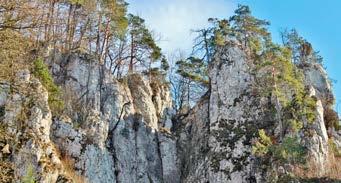
For more info visit iyp.me/ojcow
BOOK A TRIP: bit.ly/OjcowTours
If you don’t have a car, buses from Kraków to Ojców run often; use e-podroznik.pl to find connections. Numerous companies also organise tours and transport to Ojców, including EcoTravel, who offer winter sleigh rides when conditions are right (see p.63).
ZAKOPANE & THE TATRA MOUNTAINS
Kraków is conveniently located only 100km north of the Tatra Mountains, which comprise the southern border between Poland and Slovakia, and feature Poland’s tallest peaks (the highest of which is Rysy, at 2,499 metres), a multitude of caves, verdant valleys, crystal-clear mountain lakes, rustic mountain huts and over 270km of hiking trails within Tatra National Park proper.
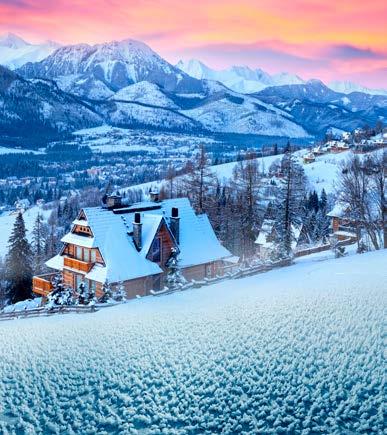
Hit the ski slopes, or just hit the esc button on life with a getaway to the Tatras.
Photo © panaramka
The gateway to this landscape for most visitors is Zakopane, a small sheep-herding village at the foothills of the High Tatras which quickly developed into a popular mountain resort in the late 19th/early 20th century. Today the town is more popular than ever, not only for its clean air, beautiful views, thermal spas, skiing and mountaineering opportunities, but also as the centre of Polish highlander culture, with its vibrant folk music and costumes, unique wooden architecture, delicious regional cuisine (including the famous oscypek, p.80) and strange mountain dialect of the Polish language. For better or worse (the latter if you ask us), ul. Krupówki - Zakopane’s high street - has become a major tourist destination for food, shopping, nightlife and entertainment, and the town has been dubbed PL’s ‘holiday capital’ due to the influx of tourists it sees nearly year-round, but particularly in the winter (for skiing) and summer (for hiking).
BOOK A TRIP: bit.ly/ZakopaneTours
Buses to Zakopane depart from Kraków frequently, with the slow journey taking over 2 hours; check e-podroznik.pl for connections. Numerous Kraków tour operators organise trips to Zakopane and the mountains, but note that each of these action-packed excursions occupies 8-12 hours.
Wadowice (John Paul II's Birthplace)
GETTING TO WADOWICE
Getting to Wadowice is best done by car or bus. Approximately 50km to the southwest on the way to Bielsko-Biała, the journey takes about 60mins by car and there is free parking less than 500m away from the main square on ul. Sienkiewicza. If you have your own vehicle, you should highly consider taking the route through Kalwaria Zebrzydowska - another fascinating Catholic pilgrimage site, which is registered on the UNESCO World Heritage List. Together, Kalwaria and Wadowice make the perfect day trip from Kraków.

Wadowice’s Minor Basilica alongside the JPII Family House Museum (centre).
Buses to Wadowice leave frequently (every 15mins on average) from Kraków’s main bus station with a journey time of about 80mins. Connections can be checked via e-podroznik.pl or busy-krk.pl/ wadowice-krakow, and tickets can be bought from the driver for about 10zł. The bus station in Wadowice is only about 10mins on foot (700m) from Plac Jana Pawła II and the museum.
To save yourself some trouble, there are numerous Kraków-based companies that offers tours and transport to Wadowice, some of which also include other popular pilgrimage sites in the area such as Kalwaria Zebrzydowska and Częstochowa. Despite being a typically charming small Polish town with a historical centre organised around a main square and church, Wadowice - with its population of less than 20,000 - would be decidedly unremarkable were it not for the simple fact that it was here on May 18, 1920 that Karol Wojtyła - the future Pope John Paul II - was born. If you know your maths, that was precisely 100 years ago, making 2020 a bit of a banner year for Wadowice. This otherwise sleepy Małopolska municipality has turned into a major place of pilgrimage, and today boasts a state-of-the-art museum dedicated to the former Pope, which makes the easy 50km trip from Kraków well worth considering for Catholics and papal enthusiasts.
WHAT TO SEE
Wadowice’s main points of interest can all be easily seen in an afternoon and revolve around the town’s small central square - now appropriately named 'Plac Jana Pawła II' (John Paul II Square). The main attraction is John Paul II's Family House - a modern, multimedia museum which immerses visitors in the great man's life and accomplishments in the very building he grew up in. Next door on Wadowice's main square stands the Virgin Mary's Offertory Minor Basilica, a rather splendid 15th century structure renovated in the 18th and the site of Karol Wojtyła's baptism on June 20, 1920. Outside the church is a large monument to the man, while inside you'll find a chapel dedicated to him, as well as another likeness in the form of a rather bizarre-looking wooden statue.
JOHN PAUL II FAMILY HOME MUSEUM
Located right on the corner of Wadowice’s main square, it was in this townhouse that the Wojtyła family lived in a small apartment from 1919 to 1938. Before going on to help change the course of the modern world, our hero was born in this very building on May 18, 1920. Karol’s mother sadly died from heart and kidney failure in 1929 when Karol was nine years old, and three years later his older brother Edmund perished from scarlet fever. Upon graduating from high school here in Wadowice, Karol and his father moved to Kraków in 1938, where Karol enrolled in Jagiellonian University shortly before the outbreak of World War II. The rest, as they say, is history, and you’ll learn it in vivid detail inside this world-class museum.
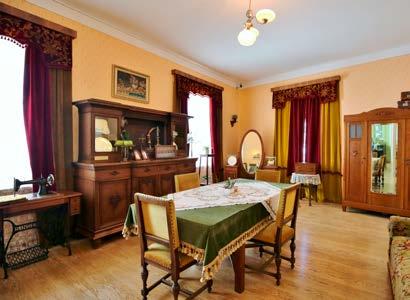
The Wojtyła family’s original flat.
Formerly housing a modest exhibition of only 200m 2 , the John Paul II Family Home was closed for renovations in 2010, while the entire building was adapted for a modern multimedia exhibition under the oversight of Barbara and Jarosław Kłaputom - the same designers of the capital’s acclaimed Warsaw Uprising Museum. Reopened in 2014, museum now comprises 16 separate zones over four floors (including the attic and basement) and a total floor space of 1200m 2 . Telling the linear story of Karol Wojtyła’s life, from his birth to his ascension to the papacy to his passing, the museum’s exhibits are enhanced with holograms, projections, lasers, video walls, touchscreens, tablets, audio recordings of the Holy Father’s speeches, and other modern means of conveyance that engage visitors of all ages, including those with disabilities or impairments.
Despite all the technical flair elsewhere, at the heart of the museum is the Wojtyła family’s original flat, modestly consisting of a bedroom, living room and kitchen, and designed to look as it would have when the family still occupied it. Furnished with period decor, the rooms include many original family items including photographs from the family album. As visitors travel through the exhibits with young Karol they experience his grief over the passing of both his mother and brother, his love of the mountains and the nearby Kalwaria Zebrzydowska pilgrimage park (today a UNESCO World Heritage site), his student life in Kraków, the hardships of Nazi occupation, and his eventual calling to the priesthood.

Karol’s years as priest, bishop and cardinal culminate in his unlikely election in 1978 as the first non-Italian Pope in 455 years, from which many original objects are present, including his first papal cossack. Another important item is the pistol used in the failed 1981 assasination attempt on John Paul II’s life. As an ardent traveller, there is memorabilia from the Pope’s pilgrimages all over the world, particularly his numerous inspiring and influential visits to his Polish homeland. The museum tour eventually concludes in the basement where darkened rooms softly beating with the rhythm of the heart lead visitors into the final hall full of white diffused light symbolising the Pope’s communion with the saints.
All told, it’s an incredible experience, and of all the Pope museums - of which there are several in Kraków alone - this is the one most worth visiting. As such it has become one of the most popular museums in Małopolska, visited by about 250,000 people from around the world annually.
BOOK TICKETS: bilety.domjp2.pl
Visiting the John Paul II Family House Museum is done with a guide only, and it's recommended that you book in advance. The tour is conducted at specific times in groups of up to 25 people and lasts about 70mins. The building also includes a shop full of papal paraphernalia, which is a bit of a cottage industry in these parts (open 10:00-16:00). Q ul. Kościelna 7, Wadowice, tel. (+48) 33 823 35 65, www.domjp2.pl. Open 09:00-14:40 (last entry); closed last Tue of every month. Regular foreign language tour times for Feb & March: English 11:00, 14:00; French 13:20; Spanish 14:20. Tours in English, German, French, Spanish, Italian, Portuguese, Russian and Ukrainian can be arranged for any time by calling in advance or via booking@domjp2.pl. Tickets for Polish tours 23/18zł; other languages 35/28zł; Tues free.
Wieliczka
Kraków is without a doubt one of the most popular tourist cities in Central Europe, and as you’ve likely heard, one of its top tourist attractions is a salt mine actually located in Wieliczka - a small town about 15km to the southeast. An astounding 1.5 million people visit Wieliczka Salt Mine each year, and it’s hardly a recent phenomenon - people have been visiting the salt mine for literally centuries with notable guests including Nicolaus Copernicus, Johann Wolfgang von Goethe, Fryderyk Chopin, Pope John Paul II and former US prez Bill Clinton. But it’s not only tourists who come to visit. So deep is the local love for this place that in a city survey, Cracovians voted Wieliczka Salt Mine as their number one favourite thing about Kraków; again, not bad for an attraction in another town 15 km away.
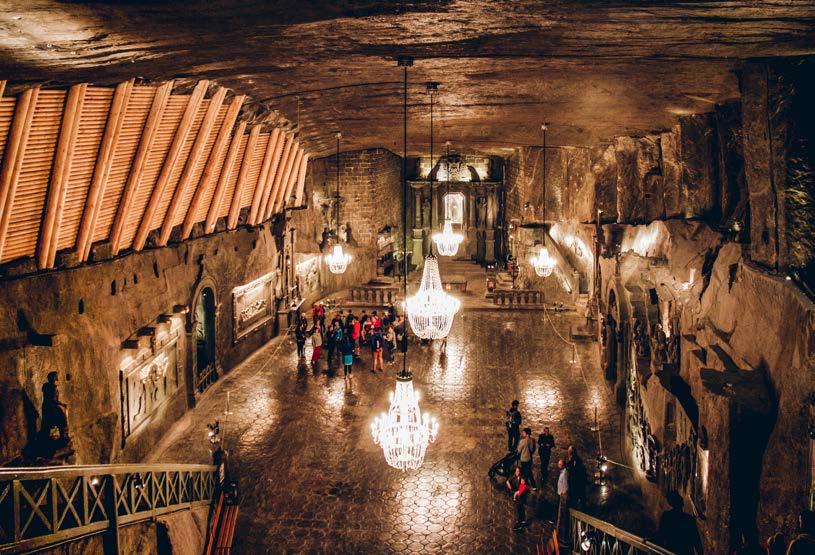
The Chapel of St. Kinga is Wieliczka Salt Mine’s crown jewel.
Alana de Haan, alanacdehaan.com
GETTING TO WIELICZKA
Getting to Wieliczka is a cinch with the E4 road east out of Kraków leading straight to the Wieliczka exit in about 15mins. Trains leave from Kraków Główny train station about once an hour, with buses running the same route inbetween train times; check malopolskiekoleje.pl for the exact schedule. Journey time is 25-45mins depending on which you choose; tickets cost 4zł and can be bought on board. Both drop you off at ‘Wieliczka Rynek Kopalnia,’ from which it’s a short walk to either the Daniłowicza Shaft (Tourist Route) or Regis Shaft (Miners’ Route) where tours begin.Q www.malopolskiekoleje.pl. One of the most famous attractions in all of Poland, Wieliczka Salt Mine has the distinction of having been included (along with Kraków’s Old Town and Kazimierz districts) on UNESCO’s first-ever World Heritage List back in 1978 (you know, back when being a World Heritage site actually meant something). Needless to say, if you’re visiting Kraków for more than a few days, you should consider a day trip out to Wieliczka. Though tourist agencies will try to convince you otherwise, bear in mind that a trip to Wieliczka does occupy the better part of a day.
WHAT TO SEE
Visiting Wieliczka’s underground realm can be done in a number of ways. Most popular is the traditional ‘Tourist Route,’ which leaves from the Daniłowicza Shaft and covers the most impressive parts of the mine, including ancient mining tools and technology, saline lakes, and numerous majestic chambers and chapels, particularly St. Kinga’s Chapel. An alternative option is the more interactive ‘Miners’ Route,’ which leaves from the Regis Shaft and involves participants being assigned a role by the foreman/ tour guide and experiencing the daily routines, rituals and secrets of working underground. As one of the oldest and most wealthy towns in Małopolska, it’s safe to assume that not all of Wieliczka’s wonders reside underground. Listed as a historical monument in 1994, the centre of the town itself - located between the two shafts - is easily walkable and perfectly charming, including a handsome town square, St. Clement’s Church, and the Saltworks Castle - which also happens to be on UNESCO’s coveted list.
WIELICZKA SALT MINE - TOURIST ROUTE
The Tourist Route is the most popular way to experience the Wieliczka Salt Mine, and it begins at the Daniłowicza Shaft, located just a short walk up ul. Daniłowicza from the Wieliczka train station. Tickets can be bought from the ticket office at the entrance, or through their website, which is the best way to see the tour times available. Frequent tours are offered in Polish, English, Russian, French, Italian, Spanish and German. Be prepared to do a lot of walking (comfortable shoes, people) and bear in mind that the mine is a constant 15 degrees Celsius.
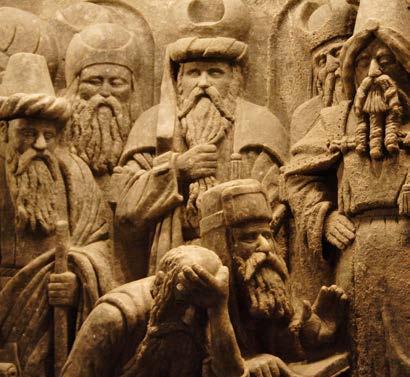
The Tourist Route takes you to a max depth of -135m, with the 3.5km covered during the 3hr tour comprising a mere 1% of this underground realm. While wandering the mine’s ancient tunnels and chambers you’ll gain insight from your guide about the history of the site, the techniques used to extract the salt and the lives of the men who worked there. The highlight of the tour is the magnificent 22,000m³ St. Kinga’s Chapel dating from the 17th century. Known for its amazing acoustics, the chapel features bas-relief wall carvings from the New Testament done by miners that display an astonishing amount of depth and realism.
Note that your ticket is valid for both the Tourist Route, which comprises the first 2hrs, and the Underground Museum which takes an additional 1hr to visit. In between there’s an opportunity to use the restrooms, get something to eat, visit the gift shop, or call it a day if that’s your preference. Though Wieliczka tour guides will suggest that the tour ends at the restaurant/gift shop, they are obliged to also escort you to and through the Underground Museum, which you have already paid for. The Museum comprises an additional 16 chambers over 1.5km packed full of artwork, artefacts and mining equipment. Highlights include two paintings by famous 19th century Polish artist Jan Matejko, and an entire room full of sparkling salt crystals.Q ul. Daniłowicza 10, Wieliczka, tel. (+48) 12 278 73 02, www.kopalnia.pl. Open 08:00-17:00. Tickets 93zł, 84zł students/seniors, 73zł kids.
WIELICZKA SALT MINE - MINERS’ ROUTE
A more interactive alternative to the mega-popular ‘Tourist Route,’ Wieliczka’s Miners’ Route offers visitors a chance to sign on as novice miners and learn the ropes of this dangerous and demanding profession. This workmanlike expedition sets off from the historic Regis Shaft, located right in the centre of Wieliczka, just a short walk east from the train station. Participants are given grey coveralls, a hard hat, headlamp and emergency respirator, assigned a locker, and told to suit up and report for underground duty. In addition to the fun of dressing up and looking slightly ridiculous, each person in the group is given a specific role by the foreman/tour guide for this 3-hour trip underground. While exploring passages and chambers that are sometimes lit only by the light of your own torches, you and your companions will learn safety measures, strange mining traditions and rituals, how to use specialised mining equipment and get a more authentic and exciting sense of what it’s like to work underground. While some members will be tasked with measuring the concentration of methane, transporting, or grinding up salt, the map readers have the challenging job of navigating the group through this extremely disorienting underground labyrinth. Szczęść Boże!
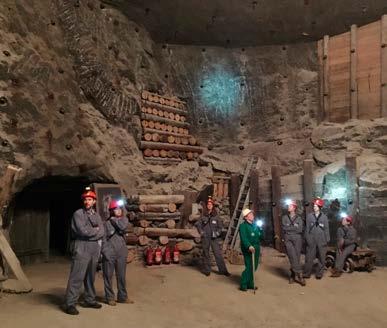
The IYP team auditions for work underground on the Miners’ Route.
BOOK A TOUR: bit.ly/WieliczkaTour
Though lacking the jaw-dropping sights of the Tourist Route, the Miners’ Route can be great fun for groups (up to 20 people); individuals can also go on their own, or join together to form a group. Tours are given at specific times in Polish or English only, and should be reserved in advance; arrive 15mins before the tour begins in order to get geared up. While hardly strenuous, this route is more active than the Tourist Route and comfortable shoes are a must. Also, bear in mind that the mine is a cool 15 degrees Centigrade.Q Plac Kościuszki 9, Wieliczka, tel. (+48) 12 278 73 02, www.kopalnia.pl. Open 09:30-15:00. Tickets 93zł, 84zł students/seniors, 73zł kids.
Auschwitz - Birkenau
For centuries the town of Oświęcim was a quiet backwater community, largely bypassed by world events. That changed with WWII when Oświęcim, known as ‘Auschwitz’ under German occupation, became the chosen site of the largest death camp in the Third Reich. Between 1.1 million and 1.5 million people were exterminated here, etching the name of Auschwitz forever into the history books and countless films, documentaries, books and survivor accounts have since burned it into the collective consciousness.
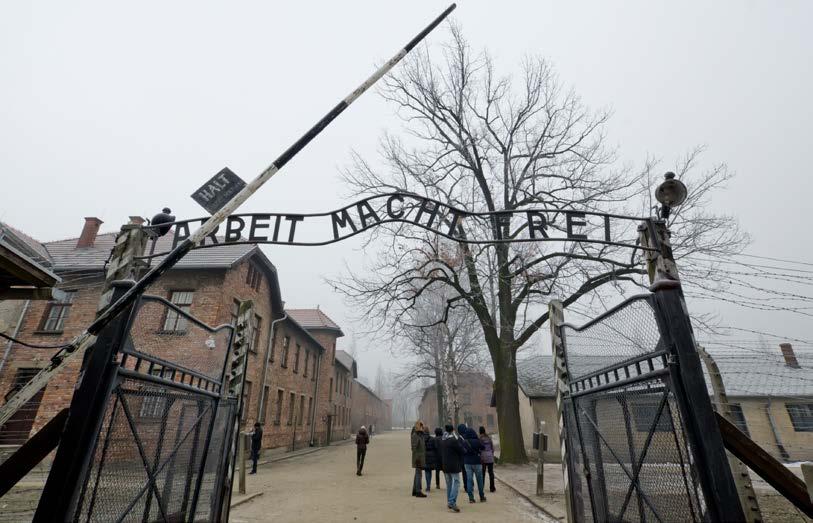
The infamous Auschwitz I entrance gate
Visitors to Kraków and Katowice are faced with asking themselves whether or not they will make the effort to visit Auschwitz. It is a difficult question. There are few who would say they actually ‘want’ to visit Auschwitz, though many are compelled to do so for their own reasons. For those of us who don’t feel so compelled, it’s easy to give reasons for not going: not having enough time, already knowing as much as we need or want to know about it, not feeling personally connected enough to the site or the history to need to visit, or being uncomfortable about the prospect of visiting a site of such emotional resonance at the same time as hundreds of other tourists. Having been there, we can tell you that all of these explanations for avoiding Auschwitz are perfectly reasonable until you’ve actually visited the site; you’ll be hard-pressed to find anyone who has made the trip and still argues against going.
The Auschwitz Museum and tour present one of the most horrific acts in human history with a level of tact, passion, poignancy and professionalism that is so profound, it almost makes as lasting an impression as the site itself. Without being heavy-handed, the history of the site is presented in all of its contexts and guests are perhaps spared from fully surrendering to their emotions only by the sheer relentlessness of the information. No matter how much you think you know on the subject, the perspective gained by visiting is incomparable. Whether or not you choose to go to Auschwitz is up to you to decide. However it should be understood that Auschwitz is not a site of Jewish concern, Polish concern, German concern, gypsy concern, historical concern... It is a site of human concern. As such, we believe everyone should visit.
VISITING AUSCHWITZ
If you’ve decided to visit Auschwitz, you basically have three options: 1) visit as part of a group organised by a tourist agency, 2) visit independently and join a guided tour at the museum, or 3) visit independently for free without a guide. Unfortunately, the latter two options are now much more difficult, as all visits must now be booked in advance through the website visit.auschwitz.org. As a result, you may find there are no tickets available because they have all been snatched up by tourist agencies. Failure to book online doesn’t mean you can’t visit Auschwitz when you want, but it does basically force you to sign up for a tour through an outside provider. This isn’t necessarily a bad thing, as it relieves you of the hassle of figuring out how to get there and back, but you will essentially be paying a surcharge for the service. For most people, however, it is worth it.
If you are determined to visit Auschwitz I independently you need to know that during peak season (March 1 - October 31) the museum makes it obligatory to buy a ticket and become part of a 3.5hr guided tour, unless you get there before 10:00 or after 16:00 (from November after 13:00) - at which times it is possible to visit for free on your own (note that last entrance to Auschwitz I is 1.5hrs before closing; Auschwitz II is always free to independent visitors). Even if visiting independently for free, you still need a ‘free ticket’ from the ticket office. Be that as it may, we strongly recommend the official guided tour, which is excellent, profound and professional; afterwards you’ll find it hard to imagine getting as much out of your visit had you explored the grounds on your own. Tour departure times fluctuate, but tours in English depart frequently; check online for exact schedule.
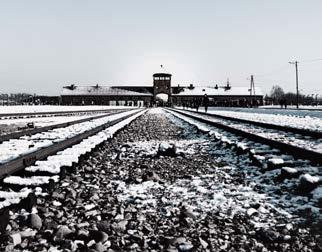
Auschwitz II - Birkenau
photo by Erica Magugliani
Arriving at the Auschwitz Museum on your own can be chaotic and confusing thanks to large crowds and unclear signage. If you are visiting independently, or in a small group, head for the queue in front of the desk marked ‘Individual Guests;’ if it’s peak season (March 1 - Oct. 31) and you don’t already have tickets (not recommended), you must first visit the white Info box located outside the entrance. Once you’re through the queues, your experience typically begins with a harrowing 20-minute film of narrated footage captured by the Soviet Army when they arrived to liberate the camp in January 1945 (an additional 6/3zł, but recommended). The film is not guaranteed, however, so in some cases your tour will begin straight away with a live guide speaking into a microphone which you hear through your headphones. If you intend to explore Auschwitz without a guide, we recommend that you give yourself several hours to explore both camps and that you pick up the official guidebook (10zł) whose map of the camp is crucial to avoid missing any of the key sites.
Visiting Auschwitz is a full day’s excursion so prepare accordingly (comfortable shoes). The guided tour of Auschwitz I takes around 2 hours, so make sure you’ve eaten breakfast. After completing the tour of the first camp, there is only a short break before the bus leaves for Auschwitz-Birkenau II; in order to stay with the same tour guide, you need to catch that bus, so it would be wise to pack some food for the day (though there is some limited food available at the museum). The tour of the second camp is shorter, lasting 1-1.5 hours. Buses regularly depart back to Auschwitz I, or you can walk or catch a cab to the train station 1.5km away. At Auschwitz I there are restrooms (have change available), a fast food bar and a restaurant; there are also restrooms at Auschwitz II-Birkenau. Note that only small bags are allowed into Auschwitz I; if your bag exceeds the very small dimensions of 30x20x10cm, you’ll have to leave it somewhere; lockers are provided for this purpose.Q ul. Stanisławy Leszczyńskiej 11, Oświęcim, tel. (+48) 33 844 81 00, www.auschwitz.org. Open 07:30-16:00. From March open 07:30-17:00. Auschwitz is not recommended for those under 14 years old. An individual ticket for a foreign language guided tour of both camps costs 60/55zł. Admission without a guide (when possible) to either camp is free. The film at Auschwitz I costs 6/3zł.
Lying 75km west of Kraków, there are several ways to get to Oświęcim/Auschwitz. The easiest may be signing on for a tour organised by a multitude of Kraków-based tour companies (like Cracow City Tours or Cracow Tours) to ensure everything goes smoothly; providing transportation, tickets and general guidance, the organisational help of these outfits can eliminate significant confusion upon arrival.
BOOK A TOUR: bit.ly/AuschwitzTour
For those going the DIY route, whether by bus or train, the route planning website e-podroznik. pl is a valuable resource. Frequent buses depart for Oświęcim from Kraków’s main bus station (ul. Bosacka 18, L-4); most stop at the Auschwitz Museum entrance (called ‘Oświęcim Muzeum’), but not all, so make sure beforehand otherwise you may end up at the Oświęcim bus station which is at the other end of town. The journey takes 1hr 20-40mins and costs 12-15zł.
Frequent, almost hourly trains also run between Kraków and Oświęcim, with a journey time of 1hr 45mins - 2hrs 15mins and a cost of about 9zł; note, however, that early trains to Oświęcim can be eerily crowded, particularly on weekends. The Oświęcim train station (ul. Powstańców Śląskich 22) lies strategically between Auschwitz I and Auschwitz II-Birkenau, which are 3km apart. Local bus numbers 24-29 stop at Auschwitz I; buy a ticket (under 3zł) from the nearest kiosk.
Free museum buses regularly shuttle visitors between the two camps, or catch a cab for 15zł. Waiting minibus taxis run by Malarek Tour (+48 605 31 50 77) can take you back to Kraków from either camp - a group of eight would pay about 30-40zł/person.
Tarnów
Eighty kilometres east of Kraków lies the charming and hospitable city of Tarnów. Małopolska’s second city by size, Tarnów is absolutely dwarfed by Kraków but features many of the same cultural and architectural charms without the crushing crowds, inflated prices and occasional feelings of herd mentality that unfortunately come along with a tourist market the size of Kraków’s. On the contrary, Tarnów offers tourists the comforts of a small town with a long history and the cultural intrigue and activities of a bigger city. In addition to a well-preserved medieval Old Town - which includes a glorious Cathedral, a cute market square and Town Hall, and many pedestrian avenues - in Tarnów visitors will discover several unique and worthwhile museums, wooden churches, historic cemeteries, castle ruins and a scenic overlook, as well as dozens of artistic and historical monuments at every turn. Those with a special interest in Jewish history will still discover a city with a deep Jewish heritage, many traces of which are still in evidence today. While the town’s nightlife may not have the sizzle of Kraków, there are still plenty of bars, cafes and restaurants where you’ll find it easy to meet friendly local folks who are proud of their city and eager to present a good impression to foreigners. All told it’s enough to warrant a day trip from Kraków, or even spend one or more nights, as Tarnów makes a superb base for exploring the wealth of other sites of interest in the region.
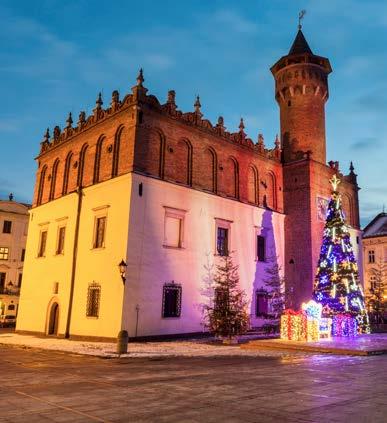
Tarnów Market Square and Town Hall.
© Krzysztof Gzyl
For more information visit tarnow.inyourpocket.com, and make sure you also pay a visit to the fine folks at the Tourist Information Office (Rynek 7; open 08:00 - 18:00; Sat, Sun 09:00-17:00) when you arrive to pick up a copy of the Tarnów In Your Pocket miniguide.
WHAT TO SEE
THE MARKET SQUARE & TOWN HALL
Tarnów’s charming market square, with its 15th century Town Hall, is the city’s crowning glory and social gravitational point. Start here.

Tarnów Market Square
THE CATHEDRAL
This red-brick Neo-Gothic wonder just off the Rynek dates back to the 14th century, and features a 72m tall tower and 5m monument of JPII.
THE OLD SYNAGOGUE BIMAH
Once the place of worship for 45% of the population, this ruined remnant of the Old Synagogue is a reminder of the city’s Jewish heritage.
THE FORMER MIKVAH
One of Tarnów’s most unique buildings, this ritual Jewish bath house was built in Moorish style in 1904; before it stands a monument to the first transport of prisoners to Auschwitz, who were detained here. Today the mikvah houses a top restaurant.
THE JEWISH CEMETERY
Dating back to the 1580s, this haunting Jewish cemetery is one of the oldest and largest in PL, and a necessary part of any visit to Tarnów.
ST. MARY’S CHURCH
This beautiful little Gothic larch wood church dates back to the 15th century and is only a four block walk south from the market square.
ST. MARTIN’S HILL
Get active and explore the ruins of Tarnowski Castle - with panoramic views of the Old Town, and see St. Martin’s - a wooden church nearby.
GETTING TO TARNÓW
Only 80km east of Kraków, Tarnów can be easily reached by car in less than one hour via the tollfree A4 highway. Buses and trains run frequently from Kraków to Tarnów, but journey times vary. Use the route-planning site e-podroznik.pl to find exact connections.

